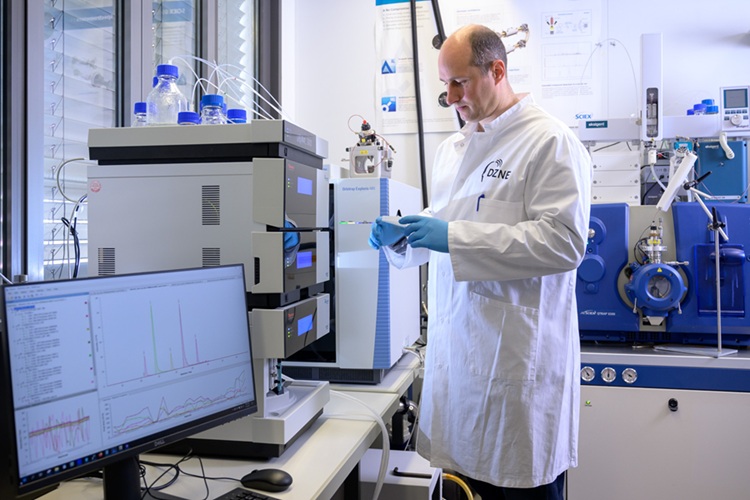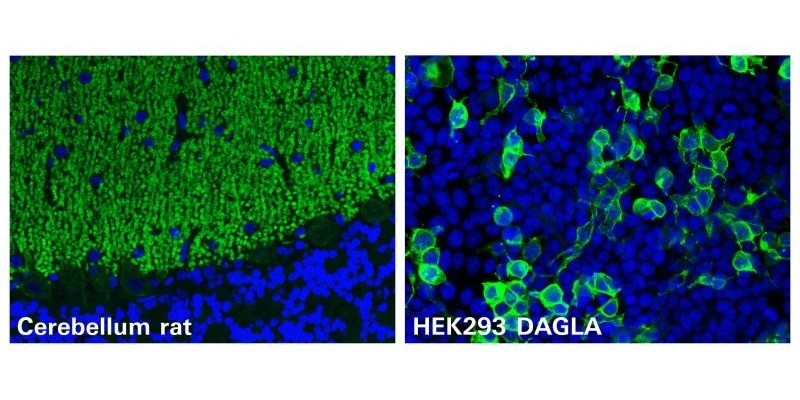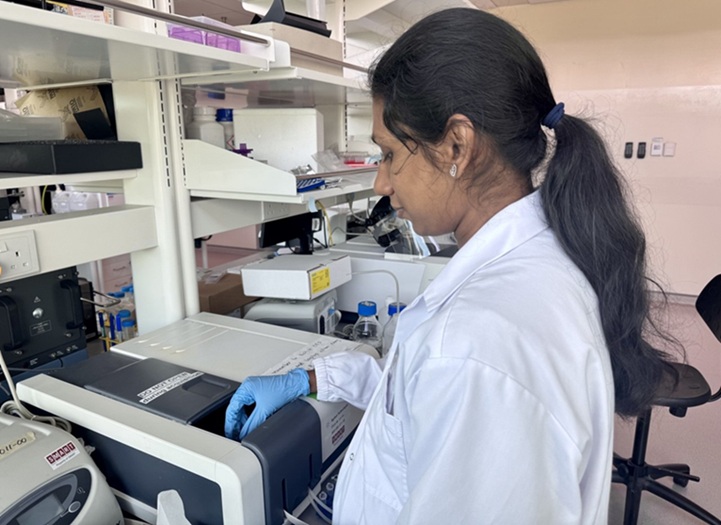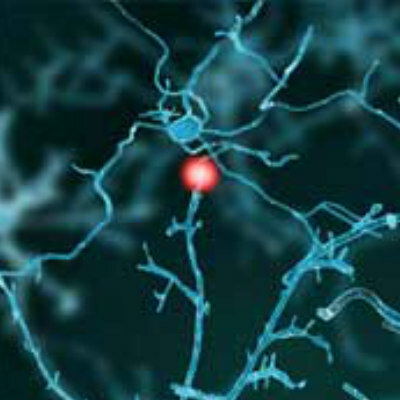LncRNAs Linked to Prostate Cancer Progression
|
By LabMedica International staff writers Posted on 06 Jun 2018 |

Image: A micrograph of prostate adenocarcinoma, acinar type, the most common type of prostate cancer (Photo courtesy of Wikimedia Commons).
A long non-coding RNA has been linked to androgen receptor signaling and the growth and development of prostate cancer.
Long non-coding RNAs (lncRNAs) are considered to be non-protein coding transcripts longer than 200 nucleotides. This somewhat arbitrary limit distinguishes lncRNAs from small regulatory RNAs such as microRNAs (miRNAs), short interfering RNAs (siRNAs), Piwi-interacting RNAs (piRNAs), small nucleolar RNAs (snoRNAs), and other short RNAs. LncRNAs have been found to be involved in numerous biological roles including imprinting, epigenetic gene regulation, cell cycle and apoptosis, and metastasis and prognosis in solid tumors. Most lncRNAs are expressed only in a few cells rather than whole tissues, or they are expressed at very low levels, making them difficult to study. Their name notwithstanding, long non-coding RNAs (lncRNAs) have been found to actually encode synthesis of small polypeptides that can fine-tune the activity of critical cellular components.
The androgen receptor (AR) plays a critical role in the development of the normal prostate as well as prostate cancer. Investigators at the University of Michigan (Ann Arbor, USA) employed an integrative transcriptomic analysis of prostate cancer cell lines and tissues to identify the lncRNA ARLNC1 (AR-regulated long noncoding RNA 1) as being strongly associated with AR signaling in prostate cancer progression. Not only was ARLNC1 induced by the AR protein, but ARLNC1 stabilized the AR transcript via RNA–RNA interaction.
The investigators further reported in the May 28, 2018, online edition of the journal Nature Genetics that in mouse models, overexpression of ARLNC1 prompted formation of large tumors, while knockdown of this lncRNA suppressed AR expression, global AR signaling, and prostate cancer growth. These findings supported a role for ARLNC1 in potentiating AR signaling during prostate cancer progression and identified ARLNC1 as a novel therapeutic target.
"The androgen receptor is an important target in prostate cancer. Understanding that target is important. This study identifies a feedback loop that we could potentially disrupt as an alternative to blocking the androgen receptor directly," said senior author Dr. Arul Chinnaiyan, professor of pathology and urology at the University of Michigan. "At the end of the day, you are creating or stabilizing more androgen receptor signaling in general and driving this oncogenic pathway forward. We are envisioning a potential therapy against ARLNC1 in combination with therapy to block the androgen receptor - which would hit the target and also this positive feedback loop. There are a number of these lncRNAs that we do not understand how they functionally work. Some of them will certainly be very useful as cancer biomarkers and we think a subset is important in biological processes."
Related Links:
University of Michigan
Long non-coding RNAs (lncRNAs) are considered to be non-protein coding transcripts longer than 200 nucleotides. This somewhat arbitrary limit distinguishes lncRNAs from small regulatory RNAs such as microRNAs (miRNAs), short interfering RNAs (siRNAs), Piwi-interacting RNAs (piRNAs), small nucleolar RNAs (snoRNAs), and other short RNAs. LncRNAs have been found to be involved in numerous biological roles including imprinting, epigenetic gene regulation, cell cycle and apoptosis, and metastasis and prognosis in solid tumors. Most lncRNAs are expressed only in a few cells rather than whole tissues, or they are expressed at very low levels, making them difficult to study. Their name notwithstanding, long non-coding RNAs (lncRNAs) have been found to actually encode synthesis of small polypeptides that can fine-tune the activity of critical cellular components.
The androgen receptor (AR) plays a critical role in the development of the normal prostate as well as prostate cancer. Investigators at the University of Michigan (Ann Arbor, USA) employed an integrative transcriptomic analysis of prostate cancer cell lines and tissues to identify the lncRNA ARLNC1 (AR-regulated long noncoding RNA 1) as being strongly associated with AR signaling in prostate cancer progression. Not only was ARLNC1 induced by the AR protein, but ARLNC1 stabilized the AR transcript via RNA–RNA interaction.
The investigators further reported in the May 28, 2018, online edition of the journal Nature Genetics that in mouse models, overexpression of ARLNC1 prompted formation of large tumors, while knockdown of this lncRNA suppressed AR expression, global AR signaling, and prostate cancer growth. These findings supported a role for ARLNC1 in potentiating AR signaling during prostate cancer progression and identified ARLNC1 as a novel therapeutic target.
"The androgen receptor is an important target in prostate cancer. Understanding that target is important. This study identifies a feedback loop that we could potentially disrupt as an alternative to blocking the androgen receptor directly," said senior author Dr. Arul Chinnaiyan, professor of pathology and urology at the University of Michigan. "At the end of the day, you are creating or stabilizing more androgen receptor signaling in general and driving this oncogenic pathway forward. We are envisioning a potential therapy against ARLNC1 in combination with therapy to block the androgen receptor - which would hit the target and also this positive feedback loop. There are a number of these lncRNAs that we do not understand how they functionally work. Some of them will certainly be very useful as cancer biomarkers and we think a subset is important in biological processes."
Related Links:
University of Michigan
Latest BioResearch News
- Genome Analysis Predicts Likelihood of Neurodisability in Oxygen-Deprived Newborns
- Gene Panel Predicts Disease Progession for Patients with B-cell Lymphoma
- New Method Simplifies Preparation of Tumor Genomic DNA Libraries
- New Tool Developed for Diagnosis of Chronic HBV Infection
- Panel of Genetic Loci Accurately Predicts Risk of Developing Gout
- Disrupted TGFB Signaling Linked to Increased Cancer-Related Bacteria
- Gene Fusion Protein Proposed as Prostate Cancer Biomarker
- NIV Test to Diagnose and Monitor Vascular Complications in Diabetes
- Semen Exosome MicroRNA Proves Biomarker for Prostate Cancer
- Genetic Loci Link Plasma Lipid Levels to CVD Risk
- Newly Identified Gene Network Aids in Early Diagnosis of Autism Spectrum Disorder
- Link Confirmed between Living in Poverty and Developing Diseases
- Genomic Study Identifies Kidney Disease Loci in Type I Diabetes Patients
- Liquid Biopsy More Effective for Analyzing Tumor Drug Resistance Mutations
- New Liquid Biopsy Assay Reveals Host-Pathogen Interactions
- Method Developed for Enriching Trophoblast Population in Samples
Channels
Clinical Chemistry
view channel
‘Brilliantly Luminous’ Nanoscale Chemical Tool to Improve Disease Detection
Thousands of commercially available glowing molecules known as fluorophores are commonly used in medical imaging, disease detection, biomarker tagging, and chemical analysis. They are also integral in... Read more
Low-Cost Portable Screening Test to Transform Kidney Disease Detection
Millions of individuals suffer from kidney disease, which often remains undiagnosed until it has reached a critical stage. This silent epidemic not only diminishes the quality of life for those affected... Read more
New Method Uses Pulsed Infrared Light to Find Cancer's 'Fingerprints' In Blood Plasma
Cancer diagnoses have traditionally relied on invasive or time-consuming procedures like tissue biopsies. Now, new research published in ACS Central Science introduces a method that utilizes pulsed infrared... Read moreMolecular Diagnostics
view channel
Simple Blood Test Improves Heart Attack and Stroke Risk Prediction
Troponin is a protein found in heart muscle cells that is released into the bloodstream when the heart is damaged. High-sensitivity troponin blood tests are commonly used in hospitals to diagnose heart... Read more
Blood Biomarker Test Could Detect Genetic Predisposition to Alzheimer’s
New medications for Alzheimer’s disease, the most common form of dementia, are now becoming available. These treatments, known as “amyloid antibodies,” work by promoting the removal of small deposits from... Read more
Novel Autoantibody Against DAGLA Discovered in Cerebellitis
Autoimmune cerebellar ataxias are strongly disabling disorders characterized by an impaired ability to coordinate muscle movement. Cerebellar autoantibodies serve as useful biomarkers to support rapid... Read more
Gene-Based Blood Test Accurately Predicts Tumor Recurrence of Advanced Skin Cancer
Melanoma, an aggressive form of skin cancer, becomes extremely difficult to treat once it spreads to other parts of the body. For patients with metastatic melanoma tumors that cannot be surgically removed... Read moreHematology
view channel
New Scoring System Predicts Risk of Developing Cancer from Common Blood Disorder
Clonal cytopenia of undetermined significance (CCUS) is a blood disorder commonly found in older adults, characterized by mutations in blood cells and a low blood count, but without any obvious cause or... Read more
Non-Invasive Prenatal Test for Fetal RhD Status Demonstrates 100% Accuracy
In the United States, approximately 15% of pregnant individuals are RhD-negative. However, in about 40% of these cases, the fetus is also RhD-negative, making the administration of RhoGAM unnecessary.... Read moreImmunology
view channel
Stem Cell Test Predicts Treatment Outcome for Patients with Platinum-Resistant Ovarian Cancer
Epithelial ovarian cancer frequently responds to chemotherapy initially, but eventually, the tumor develops resistance to the therapy, leading to regrowth. This resistance is partially due to the activation... Read more
Machine Learning-Enabled Blood Test Predicts Immunotherapy Response in Lymphoma Patients
Chimeric antigen receptor (CAR) T-cell therapy has emerged as one of the most promising recent developments in the treatment of blood cancers. However, over half of non-Hodgkin lymphoma (NHL) patients... Read moreMicrobiology
view channel
Handheld Device Delivers Low-Cost TB Results in Less Than One Hour
Tuberculosis (TB) remains the deadliest infectious disease globally, affecting an estimated 10 million people annually. In 2021, about 4.2 million TB cases went undiagnosed or unreported, mainly due to... Read more
New AI-Based Method Improves Diagnosis of Drug-Resistant Infections
Drug-resistant infections, particularly those caused by deadly bacteria like tuberculosis and staphylococcus, are rapidly emerging as a global health emergency. These infections are more difficult to treat,... Read more
Breakthrough Diagnostic Technology Identifies Bacterial Infections with Almost 100% Accuracy within Three Hours
Rapid and precise identification of pathogenic microbes in patient samples is essential for the effective treatment of acute infectious diseases, such as sepsis. The fluorescence in situ hybridization... Read morePathology
view channel
Spit Test More Accurate at Identifying Future Prostate Cancer Risk
Currently, blood tests that measure the level of a protein called prostate-specific antigen (PSA) are commonly used to identify men at higher risk for prostate cancer. This test is typically used based... Read moreDNA Nanotechnology Boosts Sensitivity of Test Strips
Since the Covid-19 pandemic, most people have become familiar with paper-based rapid test strips, also known as lateral flow immunoassays (LFIAs). These tests are used to quickly detect biomarkers that... Read more
Novel UV and Machine Learning-Aided Method Detects Microbial Contamination in Cell Cultures
Cell therapy holds great potential in treating diseases such as cancers, inflammatory conditions, and chronic degenerative disorders by manipulating or replacing cells to restore function or combat disease.... Read moreTechnology
view channel
Disposable Microchip Technology Could Selectively Detect HIV in Whole Blood Samples
As of the end of 2023, approximately 40 million people globally were living with HIV, and around 630,000 individuals died from AIDS-related illnesses that same year. Despite a substantial decline in deaths... Read more
Pain-On-A-Chip Microfluidic Device Determines Types of Chronic Pain from Blood Samples
Chronic pain is a widespread condition that remains difficult to manage, and existing clinical methods for its treatment rely largely on self-reporting, which can be subjective and especially problematic... Read more
Innovative, Label-Free Ratiometric Fluorosensor Enables More Sensitive Viral RNA Detection
Viruses present a major global health risk, as demonstrated by recent pandemics, making early detection and identification essential for preventing new outbreaks. While traditional detection methods are... Read moreIndustry
view channel
Cepheid and Oxford Nanopore Technologies Partner on Advancing Automated Sequencing-Based Solutions
Cepheid (Sunnyvale, CA, USA), a leading molecular diagnostics company, and Oxford Nanopore Technologies (Oxford, UK), the company behind a new generation of sequencing-based molecular analysis technologies,... Read more
Grifols and Tecan’s IBL Collaborate on Advanced Biomarker Panels
Grifols (Barcelona, Spain), one of the world’s leading producers of plasma-derived medicines and innovative diagnostic solutions, is expanding its offer in clinical diagnostics through a strategic partnership... Read more




















